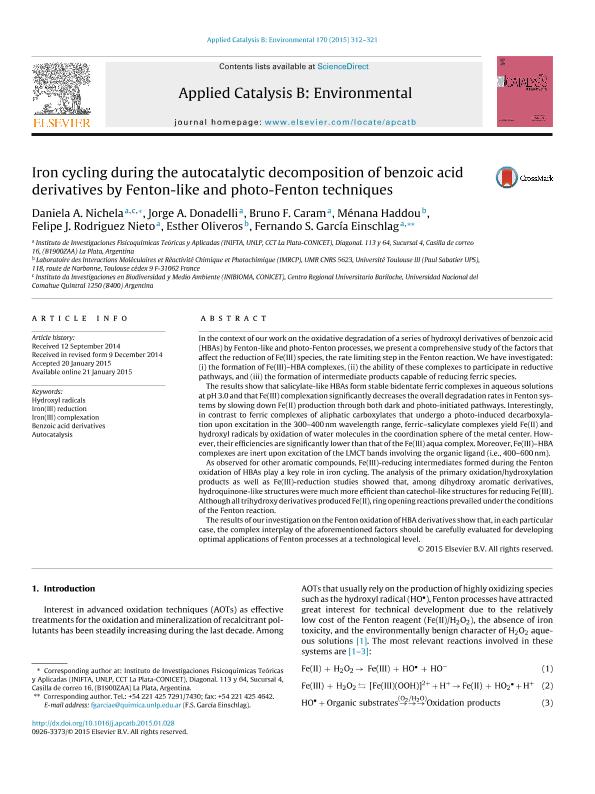Mostrar el registro sencillo del ítem
dc.contributor.author
Nichela, Daniela Alejandra

dc.contributor.author
Donadelli, Jorge Andrés

dc.contributor.author
Caram, Bruno Federico

dc.contributor.author
Haddou, Menana

dc.contributor.author
Rodríguez Nieto, Felipe Jorge

dc.contributor.author
Oliveros,Esther
dc.contributor.author
Garcia Einschlag, Fernando Sebastian

dc.date.available
2019-08-20T23:00:41Z
dc.date.issued
2015-07-21
dc.identifier.citation
Nichela, Daniela Alejandra; Donadelli, Jorge Andrés; Caram, Bruno Federico; Haddou, Menana; Rodríguez Nieto, Felipe Jorge; et al.; Iron cycling during the autocatalytic decomposition of benzoic acid derivatives by Fenton-like and photo-Fenton techniques; Elsevier Science; Applied Catalysis B: Environmental; 170-171; 21-7-2015; 312-321
dc.identifier.issn
0926-3373
dc.identifier.uri
http://hdl.handle.net/11336/81895
dc.description.abstract
In the context of our work on the oxidative degradation of a series of hydroxyl derivatives of benzoic acid (HBAs) by Fenton-like and photo-Fenton processes, we present a comprehensive study of the factors that affect the reduction of Fe(III) species, the rate limiting step in the Fenton reaction. We have investigated: (i) the formation of Fe(III)-HBA complexes, (ii) the ability of these complexes to participate in reductive pathways, and (iii) the formation of intermediate products capable of reducing ferric species.The results show that salicylate-like HBAs form stable bidentate ferric complexes in aqueous solutions at pH 3.0 and that Fe(III) complexation significantly decreases the overall degradation rates in Fenton systems by slowing down Fe(II) production through both dark and photo-initiated pathways. Interestingly, in contrast to ferric complexes of aliphatic carboxylates that undergo a photo-induced decarboxylation upon excitation in the 300-400. nm wavelength range, ferric-salicylate complexes yield Fe(II) and hydroxyl radicals by oxidation of water molecules in the coordination sphere of the metal center. However, their efficiencies are significantly lower than that of the Fe(III) aqua complex. Moreover, Fe(III)-HBA complexes are inert upon excitation of the LMCT bands involving the organic ligand (i.e., 400-600. nm).As observed for other aromatic compounds, Fe(III)-reducing intermediates formed during the Fenton oxidation of HBAs play a key role in iron cycling. The analysis of the primary oxidation/hydroxylation products as well as Fe(III)-reduction studies showed that, among dihydroxy aromatic derivatives, hydroquinone-like structures were much more efficient than catechol-like structures for reducing Fe(III). Although all trihydroxy derivatives produced Fe(II), ring opening reactions prevailed under the conditions of the Fenton reaction.The results of our investigation on the Fenton oxidation of HBA derivatives show that, in each particular case, the complex interplay of the aforementioned factors should be carefully evaluated for developing optimal applications of Fenton processes at a technological level.
dc.format
application/pdf
dc.language.iso
eng
dc.publisher
Elsevier Science

dc.rights
info:eu-repo/semantics/openAccess
dc.rights.uri
https://creativecommons.org/licenses/by-nc-nd/2.5/ar/
dc.subject
Autocatalysis
dc.subject
Benzoic Acid Derivatives
dc.subject
Hydroxyl Radicals
dc.subject
Iron(Iii) Complexation
dc.subject
Iron(Iii) Reduction
dc.subject.classification
Físico-Química, Ciencia de los Polímeros, Electroquímica

dc.subject.classification
Ciencias Químicas

dc.subject.classification
CIENCIAS NATURALES Y EXACTAS

dc.title
Iron cycling during the autocatalytic decomposition of benzoic acid derivatives by Fenton-like and photo-Fenton techniques
dc.type
info:eu-repo/semantics/article
dc.type
info:ar-repo/semantics/artículo
dc.type
info:eu-repo/semantics/publishedVersion
dc.date.updated
2019-05-27T18:04:43Z
dc.journal.volume
170-171
dc.journal.pagination
312-321
dc.journal.pais
Países Bajos

dc.journal.ciudad
Amsterdam
dc.description.fil
Fil: Nichela, Daniela Alejandra. Consejo Nacional de Investigaciones Científicas y Técnicas. Centro Científico Tecnológico Conicet - Patagonia Norte. Instituto de Investigaciones en Biodiversidad y Medioambiente. Universidad Nacional del Comahue. Centro Regional Universidad Bariloche. Instituto de Investigaciones en Biodiversidad y Medioambiente; Argentina
dc.description.fil
Fil: Donadelli, Jorge Andrés. Consejo Nacional de Investigaciones Científicas y Técnicas. Centro Científico Tecnológico Conicet - La Plata. Instituto de Investigaciones Fisicoquímicas Teóricas y Aplicadas. Universidad Nacional de La Plata. Facultad de Ciencias Exactas. Instituto de Investigaciones Fisicoquímicas Teóricas y Aplicadas; Argentina
dc.description.fil
Fil: Caram, Bruno Federico. Consejo Nacional de Investigaciones Científicas y Técnicas. Centro Científico Tecnológico Conicet - La Plata. Instituto de Investigaciones Fisicoquímicas Teóricas y Aplicadas. Universidad Nacional de La Plata. Facultad de Ciencias Exactas. Instituto de Investigaciones Fisicoquímicas Teóricas y Aplicadas; Argentina
dc.description.fil
Fil: Haddou, Menana. Université Toulouse II. Laboratoire des Interactions Moléculaires et Réactivité Chimique et Photochimique; Francia
dc.description.fil
Fil: Rodríguez Nieto, Felipe Jorge. Consejo Nacional de Investigaciones Científicas y Técnicas. Centro Científico Tecnológico Conicet - La Plata. Instituto de Investigaciones Fisicoquímicas Teóricas y Aplicadas. Universidad Nacional de La Plata. Facultad de Ciencias Exactas. Instituto de Investigaciones Fisicoquímicas Teóricas y Aplicadas; Argentina
dc.description.fil
Fil: Oliveros,Esther. Université Toulouse II. Laboratoire des Interactions Moléculaires et Réactivité Chimique et Photochimique; Francia
dc.description.fil
Fil: Garcia Einschlag, Fernando Sebastian. Consejo Nacional de Investigaciones Científicas y Técnicas. Centro Científico Tecnológico Conicet - La Plata. Instituto de Investigaciones Fisicoquímicas Teóricas y Aplicadas. Universidad Nacional de La Plata. Facultad de Ciencias Exactas. Instituto de Investigaciones Fisicoquímicas Teóricas y Aplicadas; Argentina
dc.journal.title
Applied Catalysis B: Environmental

dc.relation.alternativeid
info:eu-repo/semantics/altIdentifier/url/http://www.sciencedirect.com/science/article/pii/S0926337315000338
dc.relation.alternativeid
info:eu-repo/semantics/altIdentifier/doi/http://dx.doi.org/10.1016/j.apcatb.2015.01.028
Archivos asociados
